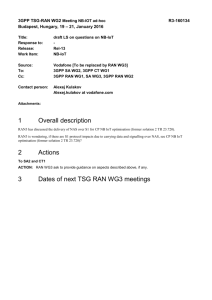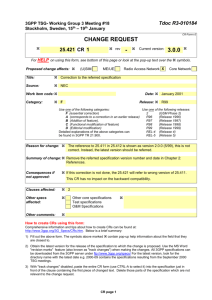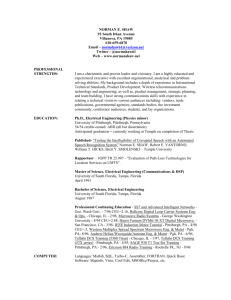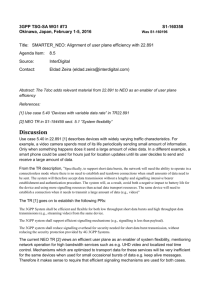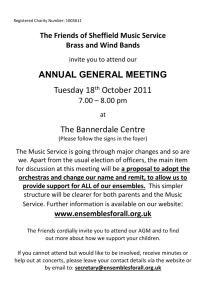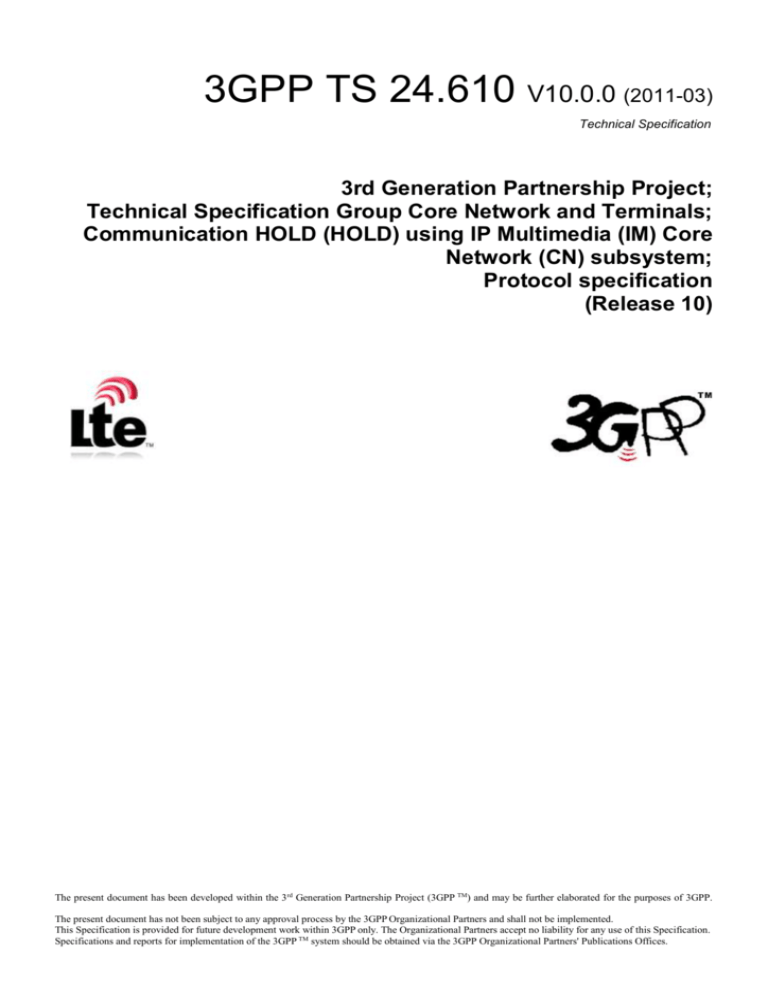
3GPP TS 24.610 V10.0.0 (2011-03)
Technical Specification
3rd Generation Partnership Project;
Technical Specification Group Core Network and Terminals;
Communication HOLD (HOLD) using IP Multimedia (IM) Core
Network (CN) subsystem;
Protocol specification
(Release 10)
The present document has been developed within the 3 rd Generation Partnership Project (3GPP TM) and may be further elaborated for the purposes of 3GPP.
The present document has not been subject to any approval process by the 3GPP Organizational Partners and shall not be implemented.
This Specification is provided for future development work within 3GPP only. The Organizational Partners accept no liability for any use of this Specification.
Specifications and reports for implementation of the 3GPP TM system should be obtained via the 3GPP Organizational Partners' Publications Offices.
Release 10
2
3GPP TS 24.610 V10.0.0 (2011-03)
Keywords
hold, supplementary service, LTE
3GPP
Postal address
3GPP support office address
650 Route des Lucioles - Sophia Antipolis
Valbonne - FRANCE
Tel.: +33 4 92 94 42 00 Fax: +33 4 93 65 47 16
Internet
http://www.3gpp.org
Copyright Notification
No part may be reproduced except as authorized by written permission.
The copyright and the foregoing restriction extend to reproduction in all media.
© 2011, 3GPP Organizational Partners (ARIB, ATIS, CCSA, ETSI, TTA, TTC).
All rights reserved.
UMTS™ is a Trade Mark of ETSI registered for the benefit of its members
3GPP™ is a Trade Mark of ETSI registered for the benefit of its Members and of the 3GPP Organizational Partners
LTE™ is a Trade Mark of ETSI currently being registered for the benefit of its Members and of the 3GPP Organizational Partners
GSM® and the GSM logo are registered and owned by the GSM Association
3GPP
Release 10
3
3GPP TS 24.610 V10.0.0 (2011-03)
Contents
Foreword............................................................................................................................................................. 5
1
Scope ........................................................................................................................................................ 6
2
References ................................................................................................................................................ 6
3
Definitions and abbreviations................................................................................................................... 6
3.1
3.2
4
4.1
4.2
4.2.1
4.3
4.3.1
4.3.2
4.3.3
4.3.4
4.4
4.5
4.5.1
4.5.2
4.5.2.1
4.5.2.2
4.5.2.3
4.5.2.4
4.5.2.5
4.5.2.6
4.5.2.7
4.5.2.8
4.5.2.9
4.6
4.6.1
4.6.2
4.6.3
4.6.4
4.6.5
4.6.6
4.6.7
4.6.8
4.6.9
4.6.10
4.7
4.7.1
4.7.2
4.7.3
4.8
Definitions ......................................................................................................................................................... 6
Abbreviations ..................................................................................................................................................... 6
Communication Hold (HOLD) ................................................................................................................ 7
Void ................................................................................................................................................................... 7
Description ......................................................................................................................................................... 7
General description ...................................................................................................................................... 7
Operational requirements ................................................................................................................................... 7
Provision/withdrawal ................................................................................................................................... 7
Requirements on the originating network side ............................................................................................. 7
Requirements in the network ........................................................................................................................ 7
Requirements on the terminating network side ............................................................................................ 7
Coding requirements .......................................................................................................................................... 7
Signalling requirements ..................................................................................................................................... 8
Activation/deactivation ................................................................................................................................ 8
Invocation and operation .............................................................................................................................. 8
Actions at the invoking UE .................................................................................................................... 8
Void ........................................................................................................................................................ 9
Void ........................................................................................................................................................ 9
Actions at the AS of the invoking UE .................................................................................................... 9
Void ........................................................................................................................................................ 9
Void ........................................................................................................................................................ 9
Void ........................................................................................................................................................ 9
Void ........................................................................................................................................................ 9
Actions at the held UE ............................................................................................................................ 9
Interaction with other services ........................................................................................................................... 9
Communication Hold (HOLD) .................................................................................................................... 9
Terminating Identification Presentation (TIP) ............................................................................................. 9
Terminating Identification Restriction (TIR) ............................................................................................... 9
Originating Identification Presentation (OIP) .............................................................................................. 9
Originating identification restriction (OIR) .................................................................................................. 9
Conference calling (CONF) ......................................................................................................................... 9
Communication DIVersion services (CDIV) ............................................................................................. 10
Malicious Communication IDentification (MCID) .................................................................................... 10
Anonymous Communication Rejection and Communication Barring (ACR/CB) ..................................... 10
Explicit Communication Transfer (ECT) ................................................................................................... 10
Interactions with other networks ...................................................................................................................... 10
Void ............................................................................................................................................................ 10
Void ............................................................................................................................................................ 10
Void ............................................................................................................................................................ 10
Parameter values (timers) ................................................................................................................................ 10
Annex A (informative):
A.1
A.1.1
A.1.2
A.1.3
A.2
A.2.1
A.2.2
Signalling Flows ............................................................................................. 11
HOLD communication ........................................................................................................................... 11
HOLD communication without announcement ............................................................................................... 11
HOLD communication with announcement .................................................................................................... 13
HOLD communication with modification of the SDP answer ........................................................................ 15
RESUME Communication ..................................................................................................................... 17
RESUME communication without announcement .......................................................................................... 17
RESUME communication with announcement ............................................................................................... 19
3GPP
Release 10
Annex B (informative):
4
3GPP TS 24.610 V10.0.0 (2011-03)
Change history ............................................................................................... 22
3GPP
Release 10
5
3GPP TS 24.610 V10.0.0 (2011-03)
Foreword
This Technical Specification (TS) was been produced by ETSI Technical Committee Telecommunications and Internet
converged Services and Protocols for Advanced Networking (TISPAN) and originally published as
ETSI TS 183 010 [7]. It was transferred to the 3rd Generation Partnership Project (3GPP) in December 2007.
The contents of the present document are subject to continuing work within the TSG and may change following formal
TSG approval. Should the TSG modify the contents of the present document, it will be re-released by the TSG with an
identifying change of release date and an increase in version number as follows:
Version x.y.z
where:
x the first digit:
1 presented to TSG for information;
2 presented to TSG for approval;
3 or greater indicates TSG approved document under change control.
y the second digit is incremented for all changes of substance, i.e. technical enhancements, corrections,
updates, etc.
z the third digit is incremented when editorial only changes have been incorporated in the document.
3GPP
Release 10
1
6
3GPP TS 24.610 V10.0.0 (2011-03)
Scope
The present document specifies the stage three Protocol Description of the Communication Hold (HOLD) services,
based on stages one and two of the ISDN Hold (HOLD) supplementary services. It provides the protocol details in the
IP Multimedia (IM) Core Network (CN) subsystem based on the Session Initiation Protocol (SIP) and the Session
Description Protocol (SDP).
The present document is applicable to User Equipment (UE) and Application Servers (AS) which are intended to
support the HOLD supplementary service.
2
References
The following documents contain provisions which, through reference in this text, constitute provisions of the present
document.
References are either specific (identified by date of publication, edition number, version number, etc.) or
non-specific.
For a specific reference, subsequent revisions do not apply.
For a non-specific reference, the latest version applies. In the case of a reference to a 3GPP document (including
a GSM document), a non-specific reference implicitly refers to the latest version of that document in the same
Release as the present document.
[1]
3GPP TS 24.229: "Internet Protocol (IP) multimedia call control protocol based on Session
Initiation Protocol (SIP) and Session Description Protocol (SDP); Stage 3".
[2]
Void.
[3]
Void
[4]
IETF RFC 3264 (2002): "An Offer/Answer Model with the Session Description Protocol (SDP)".
[5]
3GPP TS 22.173: "IP Multimedia Core Network Subsystem (IMS) Multimedia Telephony Service
and supplementary services; Stage 1".
[6]
3GPP TS 24.628: "Common Basic Communication procedures; Protocol specification".
[7]
ETSI TS 183 010 V1.2.2: "Telecommunications and Internet converged Services and Protocols for
Advanced Networking (TISPAN); NGN Signalling Control Protocol; Communication HOLD
(HOLD) PSTN/ISDN simulation services; Protocol specification".
3
Definitions and abbreviations
3.1
Definitions
For the purposes of the present document, the terms and definitions given in 3GPP TS 22.173 [5] apply.
3.2
Abbreviations
For the purposes of the present document, the following abbreviations apply:
ACR/CB
AS
CDIV
CSCF
ECT
Anonymous Communication Rejection and Communication Barring
SIP Application Server
Communication DIVersion
Call Session Control Function
Explicit Communication Transfer
3GPP
Release 10
HOLD
IMS
IP
ISDN
MCID
OIP
OIR
P-CSCF
PSTN
S-CSCF
SDP
SIP
TIP
TIR
UE
7
3GPP TS 24.610 V10.0.0 (2011-03)
communication session HOLD
IP Multimedia Subsystem
Internet Protocol
Integrated Service Digital Network
Malicious Communication IDentification
Originating Identification Presentation
Originating Identification Restriction
Proxy-CSCF
Public Switched Telephone Network
Serving-CSCF
Session Description Protocol
Session Initiation Protocol
Terminating Identification Presentation
Terminating Identification Restriction
User Equipment
4
Communication Hold (HOLD)
4.1
Void
4.2
Description
4.2.1
General description
The Communication Hold supplementary service enables a user to suspend the reception of media stream(s) of an
established IP multimedia session, and resume the media stream(s) at a later time.
4.3
Operational requirements
4.3.1
Provision/withdrawal
The HOLD service that includes announcements shall be provided after prior arrangement with the service provider.
4.3.2
Requirements on the originating network side
No specific requirements are needed in the network.
4.3.3
Requirements in the network
No specific requirements are needed in the network.
4.3.4
Requirements on the terminating network side
No specific requirements are needed in the network.
4.4
Coding requirements
No specific coding requirements are needed.
3GPP
Release 10
8
4.5
Signalling requirements
4.5.1
Activation/deactivation
3GPP TS 24.610 V10.0.0 (2011-03)
The HOLD service is activated at provisioning and deactivated at withdrawal.
4.5.1A
Registration/erasure
The HOLD service requires no registration. Erasure is not applicable.
4.5.1B
Interrogation
Interrogation of HOLD is not applicable.
4.5.2
4.5.2.1
Invocation and operation
Actions at the invoking UE
In addition to the application of procedures according to 3GPP TS 24.229 [1] , the following procedures shall be applied
at the invoking UE in accordance with RFC 3264 [4].
If individual media streams are affected, the invoking UE shall generate a new SDP offer where:
-
-
-
for each media stream that is to be held, the SDP offer that contains:
-
an "inactive" SDP attribute if the stream was previously set to "recvonly" media stream; or
-
a "sendonly" SDP attribute if the stream was previously set to "sendrecv" media stream;
for each media stream that is to be resumed, the SDP offer contains:
-
a "recvonly" SDP attribute if the stream was previously an inactive media stream; or
-
a "sendrecv" SDP attribute if the stream was previously a sendonly media stream, or the attribute may be
omitted, since sendrecv is the default; or
for each media stream that is unaffected, the media parameters in the SDP offer remain unchanged from the
previous SDP offer.
If all the media streams are to be held, the invoking UE shall generate an SDP offer containing a session level
direction attribute, or separate media level direction attributes, in the SDP that is set to:
-
"inactive" if the streams were previously set to "recvonly" media streams; or
-
"sendonly" if the streams were previously set to "sendrecv" media streams; or
If all the media streams that shall be resumed, the invoking UE shall generate a session level direction attribute, or
separate media level direction attributes, in the SDP that is set to:
-
"recvonly" if the streams were previously inactive media streams; or
-
"sendrecv" if the streams were previously sendonly media streams, or the attribute may be omitted, since
sendrecv is the default.
Then the UE shall send the generated SDP offer in a re-INVITE request (or UPDATE request) to the remote UE.
3GPP
Release 10
9
4.5.2.2
Void
4.5.2.3
Void
4.5.2.4
Actions at the AS of the invoking UE
3GPP TS 24.610 V10.0.0 (2011-03)
As a network option, the AS of the invoking UE shall for each media stream marked "recvonly" lower the bandwidth by
setting the "b=AS:" parameter to a small value, e.g. "b=AS:0". The "b=RR:" and "b=RS:" parameters shall be set to
values large enough to enable continuation of the RTCP flow, e.g. "b=RR:800" and "b=RS:800".
As a network option, the AS of the invoking UE shall initiate the procedures for the provision of an announcement to
the held user in accordance with 3GPP TS 24.628 [6].
4.5.2.5
Void
4.5.2.6
Void
4.5.2.7
Void
4.5.2.8
Void
4.5.2.9
Actions at the held UE
3GPP TS 24.229 [1] shall apply.
4.6
Interaction with other services
4.6.1
Communication Hold (HOLD)
Not applicable.
4.6.2
Terminating Identification Presentation (TIP)
No impact, i.e. neither service shall affect the operation of the other service.
4.6.3
Terminating Identification Restriction (TIR)
No impact, i.e. neither service shall affect the operation of the other service.
4.6.4
Originating Identification Presentation (OIP)
No impact, i.e. neither service shall affect the operation of the other service.
4.6.5
Originating identification restriction (OIR)
No impact, i.e. neither service shall affect the operation of the other service.
4.6.6
Conference calling (CONF)
If a participant of a conference invokes the HOLD service, it is not desirable to provide an announcement to the
conference. If the AS supporting the HOLD supplementary service receives a re-INVITE (or UPDATE) request which
includes the "isfocus" feature parameter in the Contact header, the AS shall not initiate the procedures for the provision
of an announcement to the held user(s).
3GPP
Release 10
4.6.7
10
3GPP TS 24.610 V10.0.0 (2011-03)
Communication DIVersion services (CDIV)
No impact, i.e. neither service shall affect the operation of the other service.
4.6.8
Malicious Communication IDentification (MCID)
No impact, i.e. neither service shall affect the operation of the other service.
4.6.9
Anonymous Communication Rejection and Communication Barring
(ACR/CB)
No impact, i.e. neither service shall affect the operation of the other service.
4.6.10
Explicit Communication Transfer (ECT)
No impact, i.e. neither service shall affect the operation of the other service.
4.7
Interactions with other networks
4.7.1
Void
4.7.2
Void
4.7.3
Void
4.8
Parameter values (timers)
Not applicable.
3GPP
Release 10
11
3GPP TS 24.610 V10.0.0 (2011-03)
Annex A (informative):
Signalling Flows
A.1
HOLD communication
Assumption is that a session has been established between UE-A and UE-B using basic communication procedures
according to 3GPP TS 24.229 [1], therefore the following signalling flows do not apply to the initial INVITE.
A.1.1
HOLD communication without announcement
The following diagram shows a communication session put on hold using a re-INVITE request . The same can be
achieved by sending an UPDATE request.
P-CSCF
A
UE-A
S-CSCF
AS
P-CSCF
B
UE:B
RTP
1. INVITE
(sendonly)
8. 200 OK
(recvonly)
2. INVITE
(sendonly)
3. INVITE
(sendonly)
6. 200 OK
(recvonly)
7. 200 OK
(recvonly)
4. INVITE
(sendonly)
5. 200 OK
(recvonly)
9. ACK
10. ACK
11. ACK
12 ACK
no RTP sent
Figure A.1.1.1: HOLD communication without announcement to the held user
1. UE-A sends a re- INVITE to UE-B to hold the session - see example in table A.1.1.1-1. Hold is done by changing
the SDP attribute. For each media stream that shall be held:
-
"a=sendonly", if the stream was previously a sendrecv media stream;
-
"a=inactive", if the stream was previously a recvonly media stream.
Table A.1.1.1-1: re-INVITE request (UE to P-CSCF)
INVITE user2_public1@home2.net;gr=urn:uuid:2ad8950e-48a5-4a74-8d99-ad76cc7fc74
;comp=sigcomp SIP/2.0
3GPP
Release 10
12
3GPP TS 24.610 V10.0.0 (2011-03)
Via: SIP/2.0/UDP [5555::aaa:bbb:ccc:ddd]:1357;comp=sigcomp;branch=z9hG4bKnashds7
Max-Forwards: 70
Route: <sip:pcscf1.visited1.net:7531;lr;comp=sigcomp>, <sip:orig@scscf1.home1.net;lr>
P-Preferred-Identity: "John Doe" <sip:user1_public1@home1.net>
P-Access-Network-Info: 3GPP-UTRAN-TDD; utran-cell-id-3gpp=234151D0FCE11
Privacy: none
From: <sip:user1_public1@home1.net>; tag=171828
To: <tel:+1-212-555-2222>
Call-ID: cb03a0s09a2sdfglkj490333
Cseq: 127 INVITE
Require: sec-agree
Proxy-Require: sec-agree
Supported: precondition, 100rel, gruu, 199
Security-Verify: ipsec-3gpp; q=0.1; alg=hmac-sha-1-96; spi-c=98765432; spi-s=87654321;
port-c=8642; port-s=7531
Contact: <sip:user1_public1@home1.net; gr=urn:uuid:f81d4fae-7dec-11d0-a765-00a0c91e6bf6
;comp=sigcomp>;+g.3gpp.icsi-ref="urn%3Aurn-7%3gpp-service.ims.icsi.mmtel"
Allow: INVITE, ACK, CANCEL, BYE, PRACK, UPDATE, REFER, MESSAGE, SUBSCRIBE, NOTIFY
Content-Type: application/sdp
Content-Length: (…)
v=0
o=- 2987933615 2987933615 IN IP6 5555::aaa:bbb:ccc:ddd
s=c=IN IP6 5555::aaa:bbb:ccc:ddd
t=0 0
m=video 3400 RTP/AVPF 98 99
b=AS:75
a=curr:qos local none
a=curr:qos remote none
a=des:qos mandatory local sendonly
a=des:qos none remote sendonly
a=inactive
a=rtpmap:98 H263
a=fmtp:98 profile-level-id=0
a=rtpmap:99:MPVMP4V-ES
m=audio 3456 RTP/AVPF 97 96
b=AS:25.4
a=curr:qos local none
a=curr:qos remote none
a=des:qos mandatory local sendonly
a=des:qos none remote sendonly
a=inactive
a=rtpmap:97 AMR
a=fmtp:97 mode-set=0,2,5,7; maxframes=2
a=rtpmap:96 telephone-event
3GPP
Release 10
A.1.2
13
3GPP TS 24.610 V10.0.0 (2011-03)
HOLD communication with announcement
The following diagram shows a communication session put on hold using a r-eINVITE reques with an announcement
being played by the AS to the held party.tThe same can be achieved by sending an UPDATE request.
P-CSCF
A
UE-A
S-CSCF
AS
P-CSCF
B
UE-B
RTP
1. INVITE
(sendonly)
2. INVITE
(sendonly)
3. INVITE
(sendonly)
4. INVITE
(sendonly)
5. INVITE
(sendonly)
8. 200 OK
(recvonly)
6. INVITE
(sendonly)
7. 200 OK
(recvonly)
9. 200 OK
(recvonly)
11. 200 OK
(recvonly)
10. 200 OK
(recvonly)
11a. Announcement to UE-B starts
12. 200 OK
(recvonly)
13. ACK
14. ACK
15. ACK
16. ACK
17. ACK
18 ACK
no RTP sent
Figure A.1.2.1: HOLD communication with announcement to the held user
1. UE-A sends an INVITE to UE-B to hold the session - see example in table A.1.2.1-1. Hold is done by changing
the SDP attribute. For each media stream that shall be held:
-
"a=sendonly", if the stream was previously a sendrecv media stream;
-
"a=inactive", if the stream was previously a recvonly media stream.
Table A.1.2.1-1: re-INVITE request (UE to P-CSCF)
INVITE user2_public1@home2.net;gr=urn:uuid:2ad8950e-48a5-4a74-8d99-ad76cc7fc74
;comp=sigcomp SIP/2.0
3GPP
Release 10
14
3GPP TS 24.610 V10.0.0 (2011-03)
Via: SIP/2.0/UDP [5555::aaa:bbb:ccc:ddd]:1357;comp=sigcomp;branch=z9hG4bKnashds7
Max-Forwards: 70
Route: <sip:pcscf1.visited1.net:7531;lr;comp=sigcomp>, <sip:orig@scscf1.home1.net;lr>
P-Preferred-Identity: "John Doe" <sip:user1_public1@home1.net>
P-Access-Network-Info: 3GPP-UTRAN-TDD; utran-cell-id-3gpp=234151D0FCE11
Privacy: none
From: <sip:user1_public1@home1.net>; tag=171828
To: <tel:+1-212-555-2222>
Call-ID: cb03a0s09a2sdfglkj490333
Cseq: 127 INVITE
Require: sec-agree
Proxy-Require: sec-agree
Supported: precondition, 100rel, gruu, 199
Security-Verify: ipsec-3gpp; q=0.1; alg=hmac-sha-1-96; spi-c=98765432; spi-s=87654321;
port-c=8642; port-s=7531
Contact: <sip:user1_public1@home1.net; gr=urn:uuid:f81d4fae-7dec-11d0-a765-00a0c91e6bf6
;comp=sigcomp>;+g.3gpp.icsi-ref="urn%3Aurn-7%3gpp-service.ims.icsi.mmtel"
Allow: INVITE, ACK, CANCEL, BYE, PRACK, UPDATE, REFER, MESSAGE, SUBSCRIBE, NOTIFY
Content-Type: application/sdp
Content-Length: (…)
v=0
o=- 2987933615 2987933615 IN IP6 5555::aaa:bbb:ccc:ddd
s=c=IN IP6 5555::aaa:bbb:ccc:ddd
t=0 0
m=video 3400 RTP/AVPF 98 99
b=AS:75
a=curr:qos local none
a=curr:qos remote none
a=des:qos mandatory local sendonly
a=des:qos none remote sendonly
a=inactive
a=rtpmap:98 H263
a=fmtp:98 profile-level-id=0
a=rtpmap:99:MPVMP4V-ES
m=audio 3456 RTP/AVPF 97 96
b=AS:25.4
a=curr:qos local none
a=curr:qos remote none
a=des:qos mandatory local sendonly
a=des:qos none remote sendonly
a=inactive
a=rtpmap:97 AMR
a=fmtp:97 mode-set=0,2,5,7; maxframes=2
a=rtpmap:96 telephone-event
3GPP
Release 10
A.1.3
15
3GPP TS 24.610 V10.0.0 (2011-03)
HOLD communication with modification of the SDP answer
The following diagram shows a communication session put on hold using a re-INVITE request with an announcement
being played by the AS to the held party. The same can be achieved by sending an UPDATE request.
P-CSCF
A
UE-A
1. INVITE
a=sendonly
AS
S-CSCF
2. INVITE
a=sendonly
P-CSCF
B
UE-B
3. INVITE
a=sendonly
4. INVITE
a=sendonly
5. INVITE
a=sendonly
6. INVITE
a=sendonly
8. 200 OK
a=recvonly
7. 200 OK
a=recvonly
9. 200 OK
a=recvonly
12. 200 OK
a=recvonly
b=AS:0
b=RS:800
b=RR:800
11. 200 OK
a=recvonly
b=AS:0
b=RS:800
b=RR:800
10. 200 OK
a=recvonly
b=AS:0
b=RS:800
b=RR:800
13. ACK
14. ACK
15. ACK
16. ACK
17. ACK
18. ACK
Figure A.1.3.1: HOLD communication with modification of the SDP answer
1. UE-A sends an INVITE request to UE-B to hold the session by changing the direction attribute to
"a=sendonly".
Table A.1.3-1: re-INVITE request (UE to P-CSCF)
INVITE user2_public1@home2.net;gr=urn:uuid:2ad8950e-48a5-4a74-8d99-ad76cc7fc74
;comp=sigcomp SIP/2.0
3GPP
Release 10
16
3GPP TS 24.610 V10.0.0 (2011-03)
Via: SIP/2.0/UDP [5555::aaa:bbb:ccc:ddd]:1357;comp=sigcomp;branch=z9hG4bKnashds7
Max-Forwards: 70
Route: <sip:pcscf1.visited1.net:7531;lr;comp=sigcomp>, <sip:orig@scscf1.home1.net;lr>
P-Preferred-Identity: "John Doe" <sip:user1_public1@home1.net>
P-Access-Network-Info: 3GPP-UTRAN-TDD; utran-cell-id-3gpp=234151D0FCE11
Privacy: none
From: <sip:user1_public1@home1.net>; tag=171828
To: <tel:+1-212-555-2222>; tag=24615
Call-ID: cb03a0s09a2sdfglkj490333
Cseq: 127 INVITE
Require: sec-agree
Proxy-Require: sec-agree
Supported: precondition, 100rel, gruu, 199
Security-Verify: ipsec-3gpp; q=0.1; alg=hmac-sha-1-96; spi-c=98765432; spi-s=87654321;
port-c=8642; port-s=7531
Contact: <sip:user1_public1@home1.net; gr=urn:uuid:f81d4fae-7dec-11d0-a765-00a0c91e6bf6
;comp=sigcomp>;+g.3gpp.icsi-ref="urn%3Aurn-7%3gpp-service.ims.icsi.mmtel"
Allow: INVITE, ACK, CANCEL, BYE, PRACK, UPDATE, REFER, MESSAGE, SUBSCRIBE, NOTIFY
Content-Type: application/sdp
Content-Length: (…)
v=0
o=- 2987933615 2987933615 IN IP6 5555::aaa:bbb:ccc:ddd
s=c=IN IP6 5555::aaa:bbb:ccc:ddd
t=0 0
m=video 3400 RTP/AVPF 98 99
b=AS:75
a=sendonly
a=rtpmap:98 H263
a=fmtp:98 profile-level-id=0
a=rtpmap:99:MPVMP4V-ES
m=audio 3456 RTP/AVPF 97 96
b=AS:25.4
a=sendonly
a=rtpmap:97 AMR
a=fmtp:97 mode-set=0,2,5,7; maxframes=2
a=rtpmap:96 telephone-event
10. The AS modifies the bandwidth attribute in the 200 (OK) response.
3GPP
Release 10
17
3GPP TS 24.610 V10.0.0 (2011-03)
Table A.1.3-2: 200 (OK) response (AS to S-CSCF)
SIP/2.0 200 OK
Via: SIP/2.0/UDP pcscf1.visited1.net;branch=z9hG4bk120f34.1
Via: SIP/2.0/UDP 1.2.3.4:1357;branch=z9hG4bKnashds7
From: <sip:user1_public1@home1.net>;tag=171828
To: <tel:+1-212-555-2222>; tag=24615
Contact: <sip:user2_public1@home2.net;gr=urn:uuid:2ad8950e-48a5-4a74-8d99ad76cc7fc74>;+g.3gpp.icsi-ref="urn%3Aurn-7%3gpp-service.ims.icsi.mmtel"
Call-ID: cb03a0s09a2sdfglkj490333
CSeq: 128 INVITE
Content-Length: (…)
v=0
o=- 2987933615 2987933615 IN IP6 5555::aaa:bbb:ccc:ddd
s=c=IN IP6 5555::aaa:bbb:ccc:ddd
t=0 0
m=video 3400 RTP/AVPF 98 99
b=AS:0
b=RS:800
b=RR:2400
a=recvonly
a=rtpmap:98 H263
a=fmtp:98 profile-level-id=0
a=rtpmap:99:MPVMP4V-ES
m=audio 3456 RTP/AVPF 97 96
b=AS:0
b=RS:800
b=RR:800
a=recvonly
a=rtpmap:97 AMR
a=fmtp:97 mode-set=0,2,5,7; maxframes=2
a=rtpmap:96 telephone-event
A.2
RESUME Communication
A.2.1
RESUME communication without announcement
The following diagram shows how a communication session is resumed using a re-INVITE request; The same can be
achieved by sending an UPDATE request.
3GPP
Release 10
18
P-CSCF
A
UE-A
S-CSCF
3GPP TS 24.610 V10.0.0 (2011-03)
AS
P-CSCF
B
UE:B
no RTP sent
1. INVITE
(sendrecv)
8. 200 OK
(sendrecv)
2. INVITE
(sendrecv)
3. INVITE
(sendrecv)
6. 200 OK
(sendrecv)
7. 200 OK
(sendrecv)
4 INVITE
(sendrecv)
5. 200 OK
(sendrecv)
9. ACK
10. ACK
11. ACK
12. ACK
RTP
Figure A.2.1.1: RESUME communication without announcement to the held user
1. UE-A sends an INVITE to UE-B to resume the session - see example in table A.2.1.1-1. Resume is done by
changing the SDP attribute. For each media stream that shall be resumed:
-
"a=sendrecv", if the stream was previously a recvonly media stream, or the attribute can be omitted, since
sendrecv is the default;
-
"a=recvonly", if the stream was previously an inactive media stream.
Table A.2.1.1-1: re-INVITE request (UE to P-CSCF)
INVITE user2_public1@home2.net;gr=urn:uuid:2ad8950e-48a5-4a74-8d99-ad76cc7fc74
;comp=sigcomp SIP/2.0
Via: SIP/2.0/UDP [5555::aaa:bbb:ccc:ddd]:1357;comp=sigcomp;branch=z9hG4bKnashds7
Max-Forwards: 70
Route: <sip:pcscf1.visited1.net:7531;lr;comp=sigcomp>, <sip:orig@scscf1.home1.net;lr>
P-Preferred-Identity: "John Doe" <sip:user1_public1@home1.net>
P-Access-Network-Info: 3GPP-UTRAN-TDD; utran-cell-id-3gpp=234151D0FCE11
Privacy: none
From: <sip:user1_public1@home1.net>; tag=171828
To: <tel:+1-212-555-2222>
3GPP
Release 10
19
3GPP TS 24.610 V10.0.0 (2011-03)
Call-ID: cb03a0s09a2sdfglkj490333
Cseq: 127 INVITE
Require: sec-agree
Proxy-Require: sec-agree
Supported: precondition, 100rel, gruu, 199
Security-Verify: ipsec-3gpp; q=0.1; alg=hmac-sha-1-96; spi-c=98765432; spi-s=87654321;
port-c=8642; port-s=7531
Contact: <sip:user1_public1@home1.net; gr=urn:uuid:f81d4fae-7dec-11d0-a765-00a0c91e6bf6
;comp=sigcomp>;+g.3gpp.icsi-ref="urn%3Aurn-7%3gpp-service.ims.icsi.mmtel"
Allow: INVITE, ACK, CANCEL, BYE, PRACK, UPDATE, REFER, MESSAGE, SUBSCRIBE, NOTIFY
Content-Type: application/sdp
Content-Length: (…)
v=0
o=- 2987933615 2987933615 IN IP6 5555::aaa:bbb:ccc:ddd
s=c=IN IP6 5555::aaa:bbb:ccc:ddd
t=0 0
m=video 3400 RTP/AVPF 98 99
b=AS:75
a=curr:qos local none
a=curr:qos remote none
a=des:qos mandatory local sendrecv
a=des:qos none remote sendrecv
a=inactive
a=rtpmap:98 H263
a=fmtp:98 profile-level-id=0
a=rtpmap:99:MPVMP4V-ES
m=audio 3456 RTP/AVPF 97 96
b=AS:25.4
a=curr:qos local none
a=curr:qos remote none
a=des:qos mandatory local sendrecv
a=des:qos none remote sendrecv
a=inactive
a=rtpmap:97 AMR
a=fmtp:97 mode-set=0,2,5,7; maxframes=2
a=rtpmap:96 telephone-event
A.2.2
RESUME communication with announcement
The following diagram shows how a communication session is resumed using a re-INVITE request after it was held
with an announcement being played by the AS to the held party. The same can be achieved by sending an UPDATE
request.
3GPP
Release 10
20
P-CSCF
A
UE-A
S-CSCF
3GPP TS 24.610 V10.0.0 (2011-03)
AS
P-CSCF
B
UE-B
no RTP sent
1. INVITE
(sendrecv)
2. INVITE
(sendrecv)
3. INVITE
(sendrecv)
4 INVITE
(sendrecv)
5. INVITE
(sendrecv)
8. 200 OK
(sendrecv)
6. INVITE
(sendrecv)
7. 200 OK
(sendrecv)
9. 200 OK
(sendrecv)
11. 200 OK
(sendrecv)
10. 200 OK
(sendrecv)
11a. Announcement to UE-B ends
12. 200 OK
(sendrecv)
13. ACK
14. ACK
15. ACK
16. ACK
17. ACK
18. ACK
RTP
Figure A.2.2.1: RESUME communication with announcement to the held user
1. UE-A sends an INVITE to UE-B to resume the session - see example in table A.2.2.1-1. Resume is done by
changing the SDP attribute. For each media stream that shall be resumed:
-
"a=sendrecv", if the stream was previously a recvonly media stream, or the attribute can be omitted, since
sendrecv is the default;
-
"a=recvonly", if the stream was previously an inactive media stream.
Table A.2.2.1-1: re-INVITE request (UE to P-CSCF)
INVITE user2_public1@home2.net;gr=urn:uuid:2ad8950e-48a5-4a74-8d99-ad76cc7fc74
;comp=sigcomp SIP/2.0
Via: SIP/2.0/UDP [5555::aaa:bbb:ccc:ddd]:1357;comp=sigcomp;branch=z9hG4bKnashds7
Max-Forwards: 70
Route: <sip:pcscf1.visited1.net:7531;lr;comp=sigcomp>, <sip:orig@scscf1.home1.net;lr>
P-Preferred-Identity: "John Doe" <sip:user1_public1@home1.net>
P-Access-Network-Info: 3GPP-UTRAN-TDD; utran-cell-id-3gpp=234151D0FCE11
Privacy: none
From: <sip:user1_public1@home1.net>; tag=171828
To: <tel:+1-212-555-2222>
3GPP
Release 10
21
3GPP TS 24.610 V10.0.0 (2011-03)
Call-ID: cb03a0s09a2sdfglkj490333
Cseq: 127 INVITE
Require: sec-agree
Proxy-Require: sec-agree
Supported: precondition, 100rel, gruu, 199
Security-Verify: ipsec-3gpp; q=0.1; alg=hmac-sha-1-96; spi-c=98765432; spi-s=87654321;
port-c=8642; port-s=7531
Contact: <sip:user1_public1@home1.net; gr=urn:uuid:f81d4fae-7dec-11d0-a765-00a0c91e6bf6
;comp=sigcomp>;+g.3gpp.icsi-ref="urn%3Aurn-7%3gpp-service.ims.icsi.mmtel"
Allow: INVITE, ACK, CANCEL, BYE, PRACK, UPDATE, REFER, MESSAGE, SUBSCRIBE, NOTIFY
Content-Type: application/sdp
Content-Length: (…)
v=0
o=- 2987933615 2987933615 IN IP6 5555::aaa:bbb:ccc:ddd
s=c=IN IP6 5555::aaa:bbb:ccc:ddd
t=0 0
m=video 3400 RTP/AVPF 98 99
b=AS:75
a=curr:qos local none
a=curr:qos remote none
a=des:qos mandatory local sendrecv
a=des:qos none remote sendrecv
a=inactive
a=rtpmap:98 H263
a=fmtp:98 profile-level-id=0
a=rtpmap:99:MPVMP4V-ES
m=audio 3456 RTP/AVPF 97 96
b=AS:25.4
a=curr:qos local none
a=curr:qos remote none
a=des:qos mandatory local sendrecv
a=des:qos none remote sendrecv
a=inactive
a=rtpmap:97 AMR
a=fmtp:97 mode-set=0,2,5,7; maxframes=2
a=rtpmap:96 telephone-event
3GPP
Release 10
22
3GPP TS 24.610 V10.0.0 (2011-03)
Annex B (informative):
Change history
Change history
Date
TSG #
TSG Doc.
CR
2005-08
2006-04
2007-04
2007-12
2008-01
2008-02
2008-04
2008-05
2008-05
2008-06 CT#40
2008-09 CT#41
2008-09 CT#41
2008-09 CT#41
2008-09 CT#41
2008-12 CT#42
2008-12 CT#42
2008-12 CT#42
2009-03 CT#43
2009-12 CT#46
2010-09 CT#49
2011-03 CT#51
CP080330
CP080533
CP080533
CP080533
CP080533
CP080865
CP080865
CP080865
CP090121
CP090923
CP100526
0001
R Subject/Comment
e
v
Publication as ETSI TS 183 010
Publication as ETSI TS 183 010
Publication as ETSI TS 183 010
Conversion to 3GPP TS 24.410
Technically identical copy as 3GPP TS 24.610 as basis for
further development.
Implemented C1-080101
Implemented C1-080886, C1-080887, C1-081090, C1081091, C1-081113
Implemented C1-081831, C1-081913
Editorial changes done by MCC
CP-080330 was approved by CT#40 and version 8.0.0 is
created by MCC for publishing
Correction of Activation/deactivation of HOLD
Old
New
1.1.1
1.2.1
1.2.2
1.2.3
1.2.4
1.3.0
1.4.0
1.5.0
1.5.0 1.5.1
1.5.1 8.0.0
8.0.0 8.1.0
0002
1 Miscellaneous clean-up corrections
8.0.0 8.1.0
0003
Applicability statement in scope
8.0.0 8.1.0
0004
Interaction of HOLD and CONF
8.0.0 8.1.0
0005
1 Holding or resuming all media streams
8.1.0 8.2.0
0006
2 Contents of SDP offer in HOLD
8.1.0 8.2.0
0007
1 Fixed the flows
8.1.0 8.2.0
0008
0009
0014
Correction of URN-value for Service Identifiers
1 Correction of icsi-ref feature tag
8.2.0 8.3.0
8.3.0 9.0.0
HOLD corrections
9.0.0 9.1.0
Upgrade to Rel-10
9.1.0 10.0.
0
3GPP


